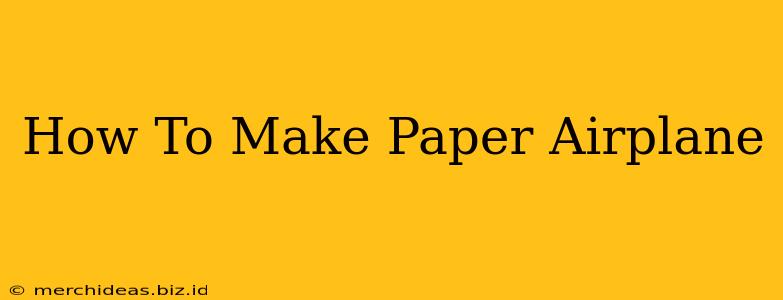So you want to make a paper airplane? Not just any paper airplane, but one that soars gracefully through the air, defying gravity (almost!) and impressing your friends? You've come to the right place! This guide will walk you through creating several different paper airplane designs, from simple to more advanced, ensuring flight success every time. Let's get folding!
Choosing Your Paper: The Foundation of Flight
Before we even start folding, let's talk about paper. The right paper is crucial for a successful paper airplane. While you can use pretty much any paper, some types perform better than others.
- Standard Printer Paper: This is a readily available and reliable option. Its weight and texture are generally good for beginners.
- Lightweight Construction Paper: A bit stiffer than printer paper, this can create a more durable plane.
- Specialty Origami Paper: While beautiful, this paper's thinness can sometimes make it challenging for beginners.
Avoid: Using heavily textured or coated paper. These types of paper tend to wrinkle easily and don't fly as well.
The Classic Dart: Easy Peasy Paper Airplane
This is the quintessential paper airplane design – simple to make and fun to fly. Follow these steps:
- Fold in Half: Start with a rectangular sheet of paper. Fold it in half lengthwise, crease sharply, and unfold.
- Fold Top Corners: Fold the top two corners towards the center crease, aligning the edges.
- Fold Down the Top: Fold the top edges down to meet the center crease.
- Fold Wings: Fold each wing down along the sides, creating the plane's wings. Adjust the angles of the wings to fine-tune the flight path. Experiment!
Pro Tip: A sharper crease improves the plane's aerodynamics. Use your fingernail or a bone folder to create crisp folds.
The Advanced Dart: Taking it to the Next Level
This design builds upon the classic dart, adding a bit more complexity for longer and more controlled flights.
- Follow Steps 1-3 from the Classic Dart.
- Fold Wings Differently: Instead of simply folding the wings down, make a smaller fold at the top of each wing, forming a slightly curved wing shape.
- Adjust Wing Flaps: Experiment with adjusting the flaps on the wings. This affects stability and flight duration.
Pro Tip: The smaller the wing flaps, the faster and more agile your airplane will be.
Beyond the Basics: Exploring Other Designs
Once you've mastered the dart, explore other designs! Search online for "paper airplane designs" and discover the amazing variety of models available. Some popular options include:
- The Simple Glider: Known for its long, gliding flights.
- The Boomerang: A fun design that tries (sometimes successfully!) to return to the thrower.
- The Fighter Jet: A more complex design with intricate folds that result in a powerful, fast flight.
Tips for a Successful Flight
- Proper Throwing Technique: Hold the plane firmly, but gently. Launch with a smooth, overhand motion. Practice makes perfect!
- Adjust Wing Flaps: Fine-tune the plane's flight by adjusting the angle of the wing flaps. This will greatly influence stability and flight path.
- Experiment: Don't be afraid to experiment! Try different paper types, folding techniques, and throwing styles to see what works best.
Conclusion: Fly High and Have Fun!
Creating paper airplanes is a fun and rewarding activity. With a little practice, you'll be able to create stunning flights and impress everyone around you. Remember, the key is experimentation and having fun. So grab some paper, unleash your creativity, and let your paper creations soar!
